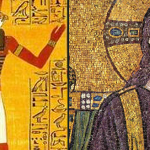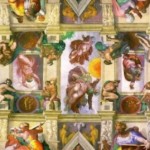How Catholics Understand the Bible
NOTE: Over the past several months, we've had lots of combox discussion about how Catholics read and interpret the Bible. To help us all make sense of this question, we're beginning a multi-part series on the topic. Once a week, for the next several weeks, Mark Shea will unpack how Catholics authentically read the Bible. Today he offers a general introduction, next week he'll outline three specific guidelines, and the following week he'll begin covering the three main spiritual senses (or lenses) through which Catholic interpret the Bible—allegorical, moral, and anagogical.
Some atheists, like Bill Maher, creator of the documentary "Religulous", imagine that people who take the Bible seriously must read it literalistically. However, there is a difference between literalistic interpretation—which is the habit of all Fundamentalists—and the literal sense of Scripture. The Catechism of the Catholic Church describes the literal sense this way:
"The literal sense is the meaning conveyed by the words of Scripture and discovered by exegesis, following the rules of sound interpretation: 'All other senses of Sacred Scripture are based on the literal'." (CCC, 116)
Getting at the literal sense of Scripture involves not mindlessly chanting, “God said it; I believe it; that settles it” in the same way a Muslim shouts “Allahu akbar!” but reading like an adult and distinguishing between the various literary forms by which Scripture reveals to us Jesus Christ. It involves, in short, learning to discern what the author was actually trying to assert, the way he was trying to assert it, and what is incidental to that assertion.
So when an Old Testament writer tells me that the land of Canaan was “flowing with milk and honey” it does not mean that he believed a chemical analysis of the river Jordan would reveal a mixture of bovine glandular secretions and bee vomit. But neither does it mean he meant nothing. Rather it means (obviously) that he knew the land of Canaan to be what it was: an agriculturally rich area where Israel could settle down and be very happy raising farms, flocks, and kidlets.
Fair enough. But, of course, Scripture says quite a lot of other things that involve real claims of the supernatural (or appear to). What do we make of them?
The first thing we have to do is wipe any sneers off our faces. Guys of the Maher school of biblical criticism imagine they are being hard-headed thinkers when they reflexively reject the possibility of the miraculous. One of their favorite slogans is “Skepticism is the chastity of the intellect.” The problem is: that’s not true. Skepticism is, in fact, the sterility of the intellect, just as credulity is. Take either skepticism or credulity too far and you wind up thinking nonsense (as when Maher extends his skepticism to reject, not just the unseen reality of God, but the unseen reality of disease-causing germs or a faith healing devotee chalks up every head cold to a demon). Or worse, you wind up not thinking at all, as when H.G. Wells’ skepticism in his essay "Scepticism of the Instrument” leads him to doubt whether he can know anything—or the hyper-credulous person believes it when somebody says a 900 foot tall Jesus appeared to Oral Roberts, demanding cash.
Atheists should know that reflexive skepticism and reflexive credulity are both enemies of the Catholic intellectual tradition, which counsels instead both reason and faith. Catholics believe that the devil sends both dogmatic skepticism and brainless credulity into the world as a pair so that, fearing one, we might flee to the other and be ensnared. Maheresque skeptics, living in the delusional fear that millions of Christians credulously believe the Virgin appears regularly on a grilled cheese sandwiches, runs to the opposite extreme of refusing to acknowledge the miraculous even if it walks up and hits them in the face. Oh sure, they may talk a good game about their desire for “scientific proof”, as Émile Zola did when he said he just wanted to see a cut finger dipped in Lourdes water and healed. But when confronted with a miracle (as Zola was by the miraculous healing of a tubercular woman whose half-destroyed face was healed after a bath at Lourdes) the dogmatic skeptic simply declares, as Zola did, “Were I to see all the sick at Lourdes cured, I would not believe in a miracle.” This is not reason. This is unreason: a dogmatic faith that miracles cannot happen which precedes and excludes any possible testimony to the miraculous, including the testimony of one’s own two eyes.
The sane approach to the question of the supernatural is therefore to embrace a reasonable openness to the possibility of the supernatural combined with a sensible willingness to use the sense God gave a goose. In short, it’s the same approach we use for determining all other matters of historical fact: are the witnesses really trying to tell us a miracle occurred in actual human history and are they reliable witnesses? Not all biblical documents are über-clear about these questions, but as a general rule, it’s not all that hard to tell them apart.
So, for instance, Jerome—the greatest biblical scholar of antiquity—tells us that the creation story is written “after the manner of a popular poet” or, as we say today, in mythic language. This is a shock to the Mahers of the world, who just knew from listening to other like-minded Mahers of the world that ancient Christians all took every syllable of Genesis literalistically.
On the other hand, Jerome does not poeticize when the biblical author obviously intends to be offering reportage of eyewitness accounts that are extremely close to the event. So when John tells us that Mary Magdalene saw the Risen Christ and Thomas stood with his finger poised over the wound in the hands, feet and side of the His Glorified Body, Jerome knows perfectly well John means to say, “The man I saw crucified on Good Friday is the same man I saw alive and well three days later. He is God in glorified human flesh!”
Jerome knows that John is not saying, “Jesus was eaten by wild dogs and his carcass is now scattered across the Judean wilderness, but I am sublimating my guilt by concocting a messianic myth compounded of Israelite myth, rumors of Osiris, and the delusional gestalt of me and my half-crazed friends.” Jerome, like Paul, knows that if Christ is not raised as the apostles say, then the whole thing is a load of skubala and the apostles are a bunch of lying dirtbags (1 Cor. 15:12-19). In short, Jerome knows the difference between mythic language and an eyewitness account. He can make the distinction and give each text the sort of assent it asks of him.
Now, the only question is, “How do you tell the difference between accounts of the miraculous and mere fictional tales?”
To get some tools for sorting that out there are, as the Second Vatican Council taught in Dei Verbum, three things we must take special care to do when approaching Scripture:
1. Be especially attentive “to the content and unity of the whole Scripture”;
2. Read the Scripture within “the living tradition of the whole Church”; and,
3. Be attentive to the analogy of faith.
Next week, we’ll look at how to flesh those guidelines out.
Related Posts
Note: Our goal is to cultivate serious and respectful dialogue. While it's OK to disagree—even encouraged!—any snarky, offensive, or off-topic comments will be deleted. Before commenting please read the Commenting Rules and Tips. If you're having trouble commenting, read the Commenting Instructions.













